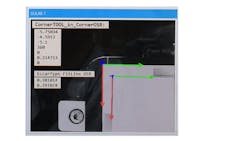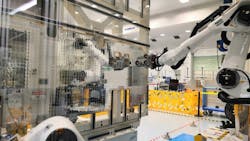Thales Alenia Space (Cannes, France) recently implemented an automated inspection and installation system in its Cannes, France manufacturing facility.
A global space industry manufacturer, the company designs, develops, builds, and operates satellites and satellite-based high-tech systems for a variety of purposes and applications, including communications, navigation systems, environmental protection, security and defense, and space exploration.
The automated system is designed to do several tasks: inspect optical solar reflectors, which Thales Alenia Space manufactures, for flaws, apply adhesive to the individual OSRs, inspect the results of that process for errors and flaws, and finally, to install the reflectors on larger solar panels. The panels, once they are covered with OSRs, are then installed as protective outer walls on space satellites.
“A panel used as an outer wall is equipped with up to 7,000 reflectors,” AKEOPLUS COO Maxime Motisi, COO of AKEOPLUS( Chateau-Gaillard, France), a systems integrator hired to complete the project, says. “Each reflector (OSR) is about 40 x 40 mm in size, and each solar panel can be up to 5 x 3 m in size.”
Thales Alenia Space engineers developed the bonding process for the OSRs, inventing a powerful glue that can withstand the extreme harsh environmental conditions of space, as well as devising the most effective pattern of applying that glue to the OSRs for installation onto the solar panels.
Before Thales Alenia Space implemented the automated process, the process of inspecting and attaching each individual reflector was done manually. This process required several human employees who worked for hours at a time in physically uncomfortable positions. These employees inspected each individual OSR for defects. Then, following a very specific, prescribed pattern, applied a specially designed industrial glue to the OSRs and attached them, one at a time, to larger solar panels. The process, conducted over multiple daily work shifts, would take two or three employees per shift at least seven days, on average, to complete a single solar panel, Motisi says.
Related content: Titan Cement Adds Inspection System to Production Facility
Designing a Machine Vision/Robotic Solution
The system the AKEOPLUS team designed on behalf of Thales Alenia Space is deployed for production in an ISO 6 clean room, which allows for a maximum of 1,000 particles per cubic meter of inside air.
The system consists of two KUKA (Augsburg, Germany) robots, three IDS Imaging Development Systems GmbH (Obersulm, Germany) 2D high resolution cameras, and a PC loaded with MVTec’s (Munich, Germany) HALCON machine vision software, programmed and integrated by ALKEOPLUS specifically for this system. Robots and cameras are hardwired to a computer set up in the clean room workspace. The entire process is monitored by one human employee using a human-machine interface developed by AKEOPLUS.
A 5 MPixel IDS camera is set up over a flat panel LED light placed on a positioning table in the workspace. This camera is used to inspect each OSR for defects such as chips, cracks, and scratches. Two 20 MPixel cameras are mounted at another station. One of these is used to inspect the glue once it is applied to the OSR. The third camera, in conjunction with a laser tracker, is used to assist in proper alignment and placement of each OSR on a solar panel.
System Performs Automatic Inspection, Guidance and Alignment, Installation
The system works like this: first, one of two robots picks up an OSR from a tray and places it on the flat panel light on the table under the first camera station. The camera captures an image of the OSR, which is transmitted to the computer and analyzed for flaws such as chips, cracks and scratches using the HALCON software. In addition, the software performs a machine vision function known as “shape matching,” which determines the OSR’s exact position and verifies that the size and shape of the OSR corresponds to the model specified in the design plan. “Position determination is very important because the robot grips each optical solar reflector slightly differently,” Motisi says.
Once this is done, the OSR is transported to the next step in the process, which is the application of the glue. The robot places the OSR under a glue dispenser nozzle, where it is applied to the OSR according to the prescribed application pattern. Once the glue has been applied, the robot picks up the OSR again and places it in a post so that the second robot, equipped with a 2.3 m long arm, can grab it. The larger robot transports the OSR to the front of the next image processing station, where the second camera captures images of the applied glue on the OSR. This image is also analyzed via the software, which verifies that the glue has no flaws, is evenly distributed and is applied exactly according to the prescribed pattern.
Once the glue passes this inspection, the next step is to align the OSR to the arm of the robot. To facilitate this, the third high-resolution camera takes images of the OSR, then algorithms determine the three-dimensional transformation between the coordinates of the OSR corner and the coordinate system of the robot’s gripper that holds the OSR, Motisi says.
The robot arm by itself cannot achieve 100% accuracy for placement by itself, because the laser tracker guiding the arm has to use the corner of the arm’s gripper surface, rather than the corner of the OSR itself, as an origin point. So, the AKEOPLUS team had to develop an algorithm that can measure the distance between the corner of the OSR and the gripper surface to calculate where the OSR should be installed on the panel’s surface, Motisi says. Once that calculation is made, the robot arm then places the OSR onto the solar panel.
Related Content: Autonomous Excavator Builds Retaining Wall
A Successful Vision System
The system has proven to be successful, Motisi says. It has automated onerous, repetitive, physically demanding tasks, reduced the number of employees needed, and has cut the time it takes to complete the OSR installations on a solar panel—from seven to around five days per panel.
Thales Alenia Space may deploy a similar, smaller system for use in another manufacturing facility located in Torino, Italy, according to Motisi.
Related Content: Automated Punch and Die Maintenance Significantly Boosts Productivity
About the Author
Jim Tatum
Senior Editor
VSD Senior Editor Jim Tatum has more than 25 years experience in print and digital journalism, covering business/industry/economic development issues, regional and local government/regulatory issues, and more. In 2019, he transitioned from newspapers to business media full time, joining VSD in 2023.



